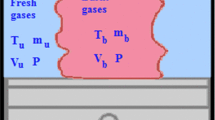Abstract
A two-dimensional model of the working process—the preliminary analysis of calculations (PAC)—is developed for the preliminary planning of three-dimensional numerical calculations of the working process in spark-ignited engines. The model is based on solving the energy conservation equation in partial derivatives based on the control volume method with explicit identification of the flame front. A new approach to modeling flame propagation in a spark-ignited engine is proposed, which consists of a combination of the mesh method of control volumes and the calculation of the apparent flame velocity based on the experimental data (taking into account the stage of development of the flame source). In this case, there is no need to solve the momentum transfer equation and gas mixture components to determine the current position of the flame front. Thus, the advantages of this model are the fast execution of the calculation and good predictive ability. Additionally, the program can be used for preliminary verification of three-dimensional calculations when experimental data are not available, as well as for obtaining the heat release characteristics for zero-dimensional (thermodynamic) models of the working process.





Similar content being viewed by others
REFERENCES
Grundlagen Verbrennungsmotoren: Simulation der Gemischbildung, Verbrennung, Schadstoffbildung und Aufladung. Praxis, Ed. by G. P. Merker and C. Schwarz (Vieweg + Teubner, Wiesbaden, 2012).
R. Pischinger, M. Klell, and T. Sams, Thermodynamik der Verbrennungskraftmaschine—Der Fahrzeugantrieb (Springer, Wien, 2002).
R. Basshuesen and F. Schäfer, Handbuch. Verbrennungsmotor (Vieweg & Sohn, Wiesbaden, 2007).
F. Perini, F. Paltrinieri, and E. Mattarelli, “A quasi-dimensional combustion model for performance and emissions of SI engines running on hydrogen–methane blends,” Int. J. Hydrogen Energy 35 (10), 4687–4701 (2010). https://doi.org/10.1016/j.ijhydene.2010.02.083
Z. Liu and R. Chen, “A zero-dimensional combustion model with reduced kinetics for SI engine knock simulation,” Combust. Sci. Technol. 181 (6), 828–852 (2009). https://doi.org/10.1080/00102200902864704
S. V. Patankar, Numerical Heat Transfer and Fluid Flow (Hemisphere, New York, 1980; Energoatomizdat, Moscow, 1984).
B. Enaux, V. Granet, O. Vermorel, C. Lacour, C. Pera, C. Angelberger, and T. Poinsot, “LES study of cycle-to-cycle variations in a spark ignition engine,” Proc. Combust. Inst. 33 (2), 3115–3122 (2011). https://doi.org/10.1016/j.proci.2010.07.038
A. S. Sokolik, Self-Ignition, Flame, and Detonation in Gases (Akad. Nauk SSSR, Moscow, 1960) [in Russian].
Ya. B. Zeldovich, G. I. Barenblat, V. B. Librovich, and G. M. Makhviladze, The Mathematical Theory of Combustion and Explosions (Nauka, Moscow, 1980; Consultants Bureau / Plenum, New York, 1985).
S. M. Frolov, V. S. Ivanov, B. Basara, and M. Suffa Poinsot, “Numerical simulation of flame propagation and localized preflame autoignition in enclosures,” J. Loss Prev. Process Ind. 26 (2), 302–309 (2013). https://doi.org/10.1016/j.jlp.2011.09.007
C. Huang, E. Yasari, L. C. R. Johansen, S. Hemdal, and A. N. Lipatnikov, “Application of flame speed closure model to RANS simulations of stratified turbulent combustion in a gasoline direct-injection spark-ignition engine,” Combust. Sci. Technol. 188 (1), 98–131 (2016). https://doi.org/10.1080/00102202.2015.1083988
G. Woschni, “A universally applicable equation for the instantaneous heat transfer coefficient in the internal combustion engine,” SAE Technical Paper 670931 (1967). https://doi.org/10.4271/670931
R. Z. Kavtaradze, Local Heat Transfer in Piston Engines (Mosk. Gos. Tech. Univ. im. N. E. Baumana, Moscow, 2007) [in Russian].
B. E. Launder and D. B. Spalding, “The numerical computation of turbulent flow,” Comput. Methods Appl. Mech. Eng. 3 (2), 269–289 (1974). https://doi.org/10.1016/0045-7825(74)90029-2
R. C. Reid, J. M. Prausnitz, and T. K. Sherwood, The Properties of Gases and Liquids (McGrawHill, New York, 1977; Khimiya, Leningrad, 1982).
S. V. Patankar, Computation of Conduction and Duct Flow Heat Transfer (Innovative Research, Maple Grove, MN, 1991; Izd. MEI, Moscow, 2003).
http://numpy.scipy.org.
B. J. McBride, M. J. Zehe, and S. Gordon, “NASA Glenn coefficients for calculating thermodynamic properties of individual species,” Technical Report No. NASA/TP–2002-211556 (NASA, Glenn Research Center, Cleveland, OH, 2002).
N. Chindaprasert, Thermodynamic Based Prediction Model for NOx and CO Emissions from a Gasoline Direct Injection Engine, Doktor-Ingenieur (Dr.-Ing.) Dissertation (Universität Rostock, 2007). https://doi.org/10.18453/rosdok_id00000329.
A. Kaden, R. Klumpp, and C. Enderle, “Analyse der Restgasverträglichkeit beim Ottomotor–Ergänzung der Verbrennungsdiagnostik durch die 3D-Motorprozessberechnung,” in 6. Internationales Symposium für Verbrennungsdiagnostik (Baden-Baden, 2002), pp. 57–67.
Author information
Authors and Affiliations
Corresponding author
Ethics declarations
The author declares that he has no conflicts of interest.
Rights and permissions
About this article
Cite this article
Sergeev, S.S. Two-Dimensional Model for Calculation of the Working Process of a Spark-Ignited Engine. Math Models Comput Simul 14, 559–566 (2022). https://doi.org/10.1134/S207004822204010X
Received:
Revised:
Accepted:
Published:
Issue Date:
DOI: https://doi.org/10.1134/S207004822204010X




